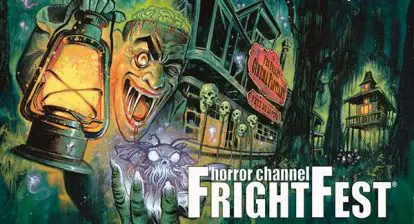Horror logic dictates we should run upstairs instead of out the front door. Horror logic assures us that entering the murky swamp/darkened house/pitch-black basement is the best and only option available and that there is absolutely nothing dangerous lurking in the shadows. Horror logic requires us to keep our blouse buttons undone even when running from a chainsaw-wielding maniac, and to engage in randy activities, alone or otherwise, to seal our fate.
A rather considerable suspension of disbelief is required in order to be a horror fan. Scary movies live or die on our ability to put ourselves in the position of the protagonist, even when we’re screaming at them not to go in there, not to open that door, or not to start canoodling when there’s a killer on the loose. This is especially true of slasher movies, which utilise the supposedly widely-held idea that one usually has the dumbest reaction possible when faced with a terrifying situation. Wes Craven rather memorably explored this idea in the seminal Scream, where one of the main characters actually stands up at a party and spells out all the ways to get yourself killed in a horror movie while these things are happening, or are about to happen.
Considering Ghostface’s victims were self-aware enough to understand exactly how scary movies function, it was that much funnier to watch Neve Campbell’s Final Girl Sidney Prescott tearing apart typical slasher tropes on the phone with her stalker, before behaving in exactly the same way as she just described once she comes face to mask with him herself. Craven was making the point that these ideas may seem stupid from the safety of your sofa but, more often than not, the immediate gut reaction isn’t always the smartest regardless of how brave we may think we are. And, as horror fans, that’s what we get off on: the naive belief that we’re smarter, coupled with the inescapable reality that we’re probably not.
In found footage flicks, the characters’ reactions seem even crazier because, no matter how bad things get, they never stop filming what’s happening to them. Ti West played around with this idea in the brilliant The Sacrament, during which a member of the documentary crew memorably flings his recording equipment aside so he can flee faster. Likewise, in this year’s MTV sexy teen production Project Almanac (a dark time travel experiment, rather than a straight-up horror film) the characters make a pact to always film everything that happens no matter what, which kind of gets around this notion but still doesn’t quite explain the reasoning behind it.The protagonists, or victims rather, aren’t the only ones acting irrationally in horror movies. Villains seem capable of, among other things; withstanding a barrage of bullets, stab-wounds and various other life-threatening injuries, teleportation, and a controlled walking speed so great that they can stroll after fleeing teenagers and still catch up to them in good time. One of the main talking points surrounding Rob Zombie’s often unfairly derided Halloween remake, and its sequel H2, was that Michael Myers (played here by hulking ex-wrestler Tyler Mane) was so massive and indestructible it was utterly implausible that he couldn’t manage to catch and kill Laurie.
Was it easier to believe that Michael Myers, as presented in Carpenter’s original as a normal dude, could be escaped or defeated? It begs the question; if the killer is sold to us as an unstoppable force who is subsequently stopped, where does the fear come from? As cynical or supposedly clued-in as most horror fans think they are (again, explored quite effectively in the Scream series), when it comes down to it, a film has to be particularly implausible and stupid not to make us shiver or, more often than not, discuss it endlessly afterwards. In fact, much of the time, it’s the dumber films that encourage the most lively discussions – when we’ve figured it out, we’re braver.
 Take Texas Chainsaw 3D,the reboot/sequel to Tobe Hooper’s still-terrifying seventies shocker. Although it’s stupidly gory, overly-stylised and at times ridiculously dumb, certain moments, such as when Leatherface literally hooks some poor lad in the back and drags him down the stairs towards him, are quite terrifying. Another extended sequence sees Leatherface sewing a new face on. These are memorable, skin-dimpling moments, but the film itself is largely throwaway. The original Texas Chain Saw, on the other hand, has one, life-ruining hook-related scene in which we see absolutely nothing and yet there are fans in their twenties and thirties who still aren’t over it.
Take Texas Chainsaw 3D,the reboot/sequel to Tobe Hooper’s still-terrifying seventies shocker. Although it’s stupidly gory, overly-stylised and at times ridiculously dumb, certain moments, such as when Leatherface literally hooks some poor lad in the back and drags him down the stairs towards him, are quite terrifying. Another extended sequence sees Leatherface sewing a new face on. These are memorable, skin-dimpling moments, but the film itself is largely throwaway. The original Texas Chain Saw, on the other hand, has one, life-ruining hook-related scene in which we see absolutely nothing and yet there are fans in their twenties and thirties who still aren’t over it.
Considering our society is incredibly PC and what’s considered scary is changing all the time, it’s comforting to know that what is basically the same scare–albeit re-imagined much rougher, for a modern audience–still hits just as hard even though, really, it doesn’t make any sense. Likewise, later, when Final Girl Alexandra Daddario is held hostage by Leatherface and her shirt hangs on just enough to cover her boobs, it’s the usual eighties slasher trope to which we’re so accustomed but it still works. We accept it, just as we accept that hiding in a coffin is a smart idea or that there’s never any phone signal anywhere.
Horror movies are a law unto themselves, often encompassing elements of other genres as vastly different as comedy, action and romance. By the same token, they don’t follow the rules of normal films. As fans, we tend to accept the logical fallacies, geographical inaccuracies and a complete lack of self-awareness/cell-phone signal/clothing, because we’re in on the joke. Horror sets itself up so that we’re aware of the danger before the characters are, so the fun comes from watching them try, and fail, to avoid it. Even if they react in the dumbest way possible, we love it. Normal people don’t understand horror logic because, when it comes down to it, there is no logic and that’s what makes it so great. And, as much as we don’t care to admit it, if faced with a chainsaw-wielding maniac, would we react any differently? Or would we simply run upstairs, get naked and continue filming no matter what?







